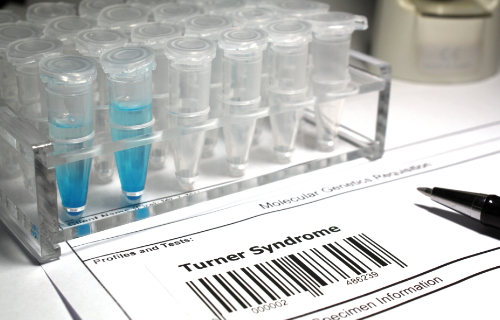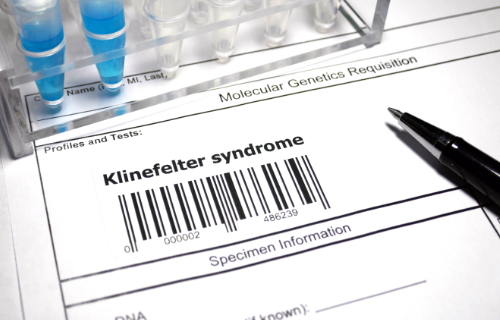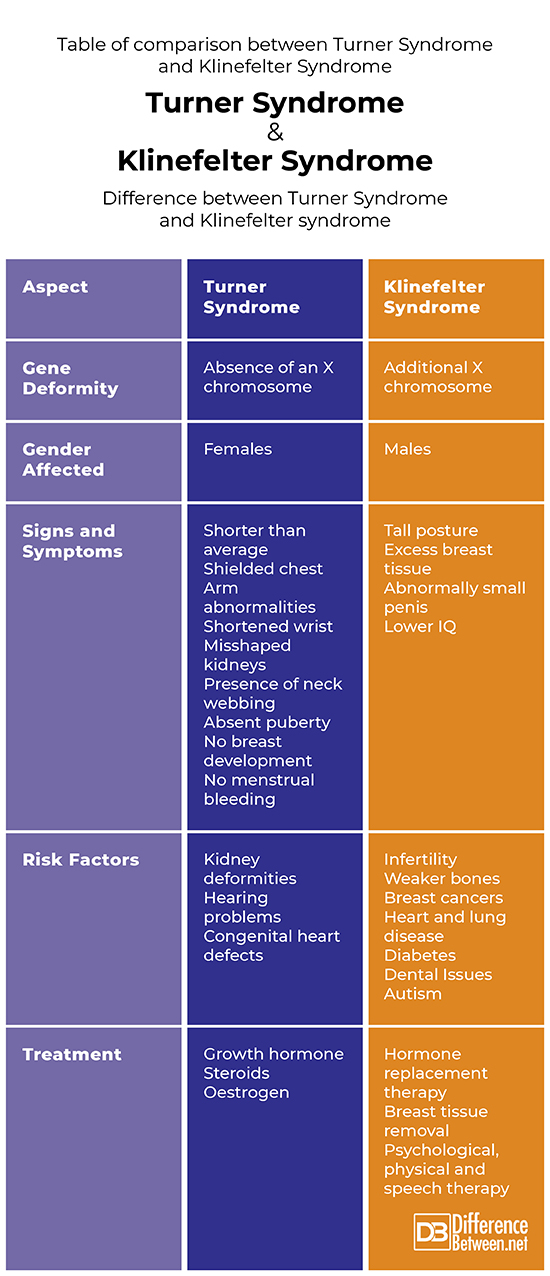Difference Between Turner Syndrome and Klinefelter Syndrome

Both Turner Syndrome and Klinefelter Syndrome are disorders stemming from genetics. Females and males are born with it, as it is not a disorder which can be caught.
Although they are both caused by genetic disorders, these two syndromes present very differently. One disorder relates to an absence of a genetic sex chromosome and the other relates to the presence of an extra genetic sex chromosome. Each is specific to either the female gender or the male gender.
The signs and symptoms of each are strongly present and makes it easier to determine a suspected diagnosis. Turner Syndrome and Klinefelter Syndrome carry associated medical risks involving organs, bones and hormones of the body. There is no “cure” for these syndromes but there are medical treatments which have been seen to be quite successful. These treatments include substituting the missing hormone production as well as an array of therapies.
Turner Syndrome and Klinefelter Syndrome are often confused with Down Syndrome. This is because Down Syndrome is also caused be a genetic abnormality. However, they are unrelated and the genetic abnormality of Down Syndrome has nothing to do with sex chromosomes.
This article aims to highlight the differences between the two genetic syndromes and help unravel what really happens!

Definition and Causes
Turner Syndrome
Turner syndrome is a genetic disorder caused by the absence (part or complete) of the X chromosome. In most cases cells only have a single X chromosome but in other cases it is seen that some cells have both X chromosomes, and some have parts of one. This syndrome occurs in females.
Klinefelter Syndrome
Males are usually born with 46 chromosomes, where one is a X, and one is a Y. It is the Y chromosome which is responsible for the male sex. Klinefelter Syndrome is a result of being born with an extra X chromosome.
Clinical Presentation and Pathophysiology
Turner Syndrome
Patients with Turner Syndrome present with a variety of clinical features or symptoms.
Newly born babies suffering from this genetic disorder are often born with puffy hands and puffed-up feet. They may also show signs of a broader chest than expected. Most are born with a normal level of intelligence but show issues with visual function.
When affected females turn 5 or 6 years old, they often appear shorter than their average expected height. Additionally, these females have a shielded chest, arm abnormalities, a shortened wrist, misshaped kidneys, and a presence of neck webbing.
In the teen years, clinical presentation is quite impactful. Adolescents often suffer from a complete failure of reaching puberty, no development of the breasts and absence of any menstrual bleeding.
Additional symptoms include generalized swelling and presenting as underweight.
Klinefelter Syndrome
Patients suffering from this genetic disease may present with clinical signs and symptoms such as a particularly tall posture, the increased presence of breast tissue, abnormally small testicles even once puberty has passed, and the absence of sperm production from the male reproductive organs.
At birth, babies might show signs of weak muscles and delayed speech.
Additionally, males may present with a generally lower IQ (of about 10-15 points) in comparison to their other siblings.
Risks and Treatment
Turner Syndrome
Individuals born with Turner Syndrome are generally at a much higher risk for developing medical health issues. These issues include kidney deformities, impaired hearing, and the presence of congenital heart defects.
The treatment options for patients with Turner Syndrome includes growth hormone. This is administered around the age of 5 or 6 and given until adolescent years. Steroids and oestrogen medications are given to patients to aid in the sexual development process.
Klinefelter Syndrome
Klinefelter Syndrome certainly has associated risks to a person’s health. This includes infertility, the presence of weaker bones, breast cancers (due to the excess breast tissue), heart disease, lung diseases, metabolic conditions such as diabetes, dental issues, and the chance of autism spectrum disorders.
The presence of low testosterone can be treated with hormone replacement therapy. This is usually started when puberty is expected. In some cases, breast tissue is removed through surgery. Therapies are also effective treatments options. More specifically, physical, speech and psychological therapy treatment methods.
Table of comparison between Turner Syndrome and Klinefelter Syndrome

Summary
Turner syndrome is a genetic disorder caused by the absence of the X chromosome in females. Klinefelter syndrome, on the other hand, is a genetic disorder caused by the presence of an extra X chromosome in males.
These syndromes both have significant clinical presentations and can both be treated by a variety of hormone therapies and other medical interventions.
FAQ
What is the truth about Turner syndrome and Klinefelter syndrome?
Turner syndrome is a genetic disorder caused by the absence (part or complete) of the X chromosome. In most cases cells only have a single X chromosome but in other cases it is seen that some cells have both X chromosomes, and some have parts of one. This syndrome occurs in females.
Males are usually born with 46 chromosomes, where one is an X and one is a Y. It is the Y chromosome which is responsible for the male sex. Klinefelter Syndrome is a result of being born with an extra X chromosome.
What is Down Syndrome, Klinefelter Syndrome and Turner Syndrome?
Down Syndrome is a genetic disorder where there are three copies of chromosome 21, Klinefelter Syndrome is a genetic disorder where there is an absent X chromosome, and Turner Syndrome is a genetic disorder where there is an additional X chromosome.
- Difference Between a Cochlear Implant and Normal Hearing - October 4, 2022
- Difference Between Obstructive and Restrictive Spirometry - September 11, 2022
- The Difference Between White Box and Black Box Testing - September 11, 2022
Search DifferenceBetween.net :
Leave a Response
References :
[0]BYJU. “Differences Between Turner Syndrome and Klinefelter Syndrome”. https://byjus.com/biology/difference-between-turnersyndrome-and-klinefeltersyndrome/
[1]Mayo Clinic. “Klinefelter syndrome”. https://www.mayoclinic.org/diseases-conditions/klinefelter-syndrome/symptoms-causes/syc-20353949
[2]Pienkowski, C., Cartault, A., Caula-Legriel, S., Ajaltouni, Z., Daudin, M. & Tauber, M. “Klinefelter’s syndrome and Turner’s syndrome. For better management”. Gynaecology, Obstetrics and Fertility, vol. 39, no. 9, 2011, pp:521-524.
